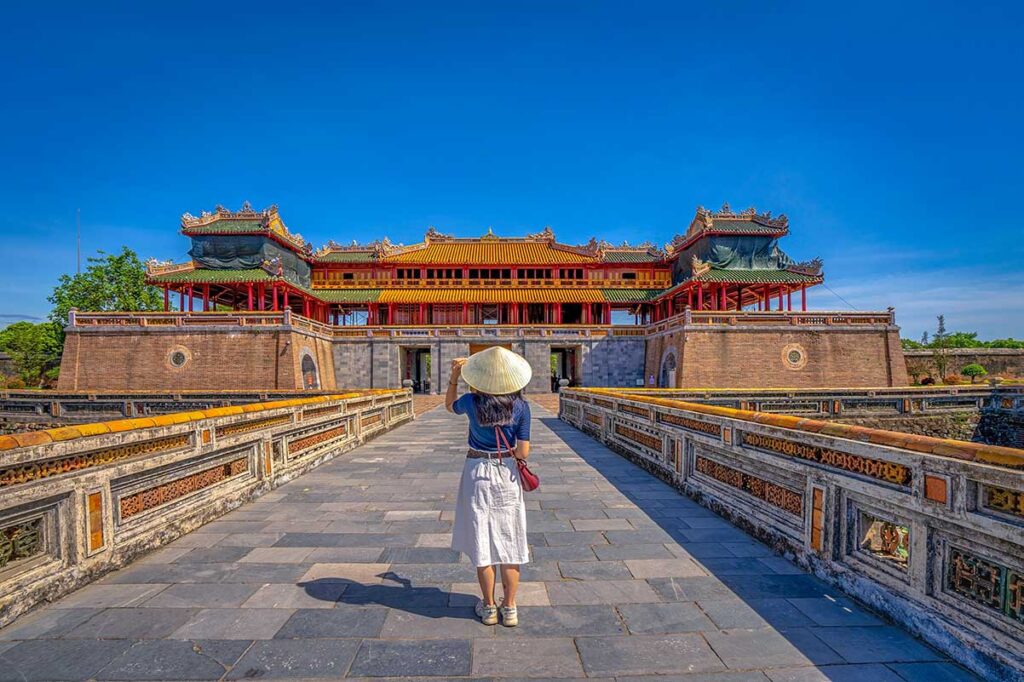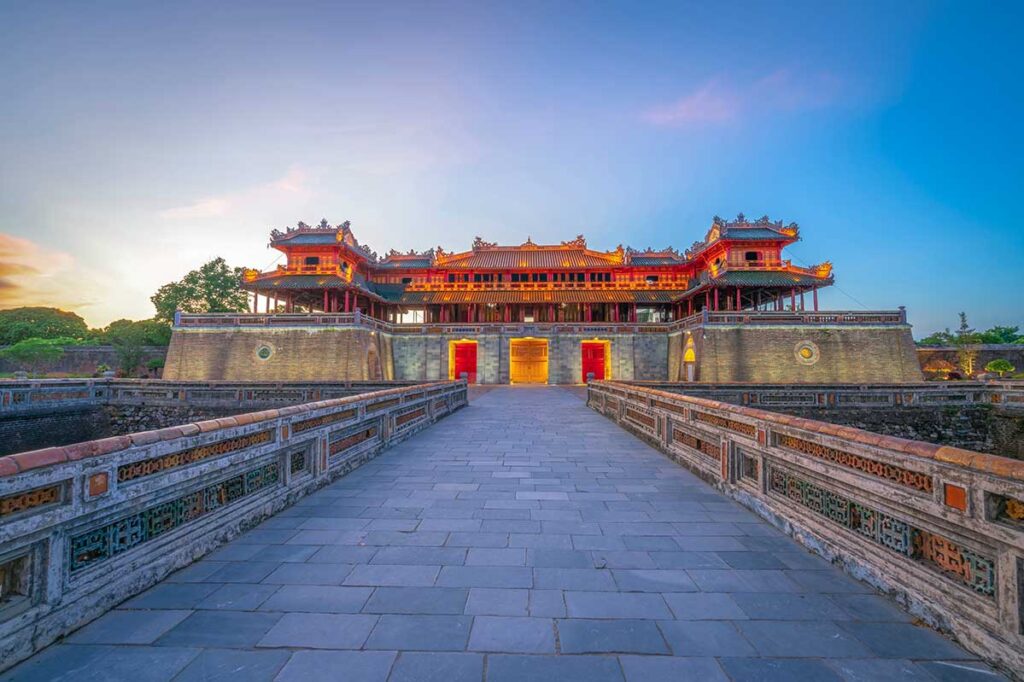Hue – Imperial history and riverside charm
Located in central Vietnam, roughly halfway between Hanoi and Ho Chi Minh City, Hue sits on the banks of the Perfume River. It served as the imperial capital from 1802 to 1945, when the Nguyen emperors built grand palaces, royal tombs, and ornate pagodas. Many of these landmarks still stand today, despite heavy damage during the Vietnam War, which also left its mark through the nearby Demilitarized Zone (DMZ).
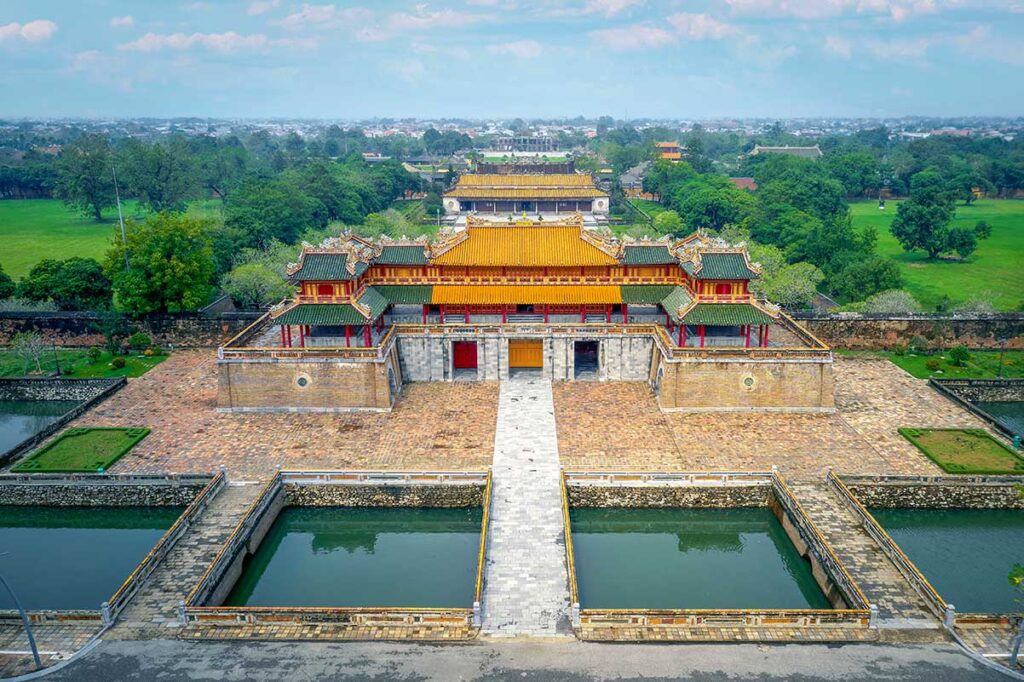
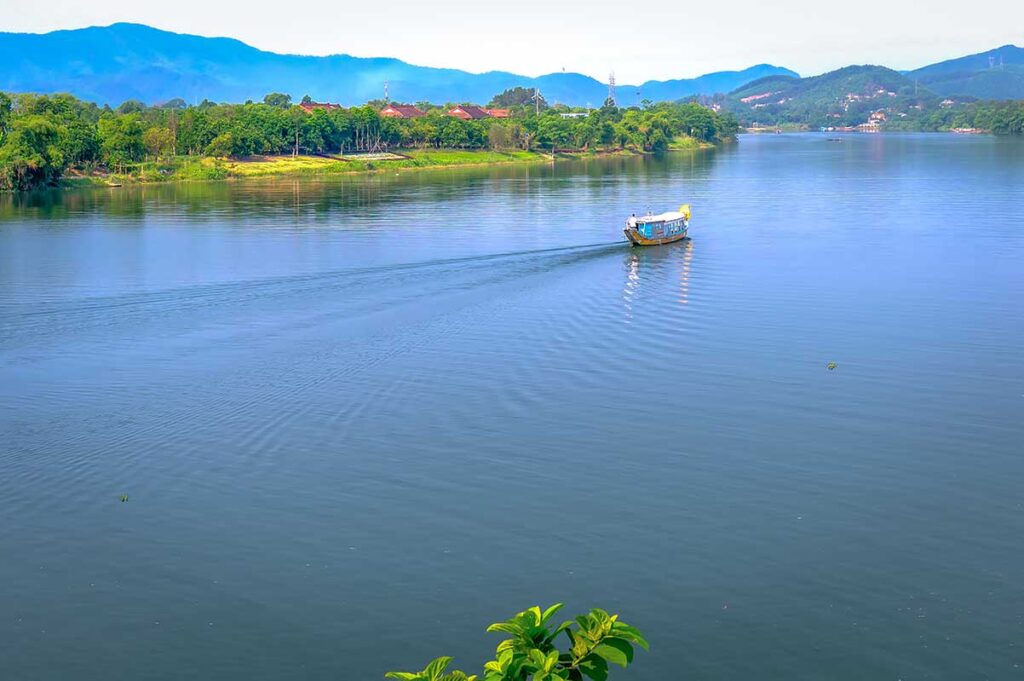
Hue is best known for its well-preserved imperial architecture, peaceful riverside setting, and distinctive cuisine. Many of the best things to do in Hue are tied to its history — from exploring the Imperial City and royal tombs to visiting centuries-old pagodas. But the city also offers vibrant markets, craft villages, scenic day trips, and some of central Vietnam’s most rewarding food experiences.
Best things to do in Hue
Hue is packed with historic landmarks, cultural treasures, and local experiences that you won’t find anywhere else in Vietnam. From grand imperial architecture to peaceful riverside temples and street food adventures, there’s a lot to fit into your trip. Here’s a curated list of the best things to do in Hue to help you plan your time.
1. Explore Hue Imperial City
What is Hue Imperial City
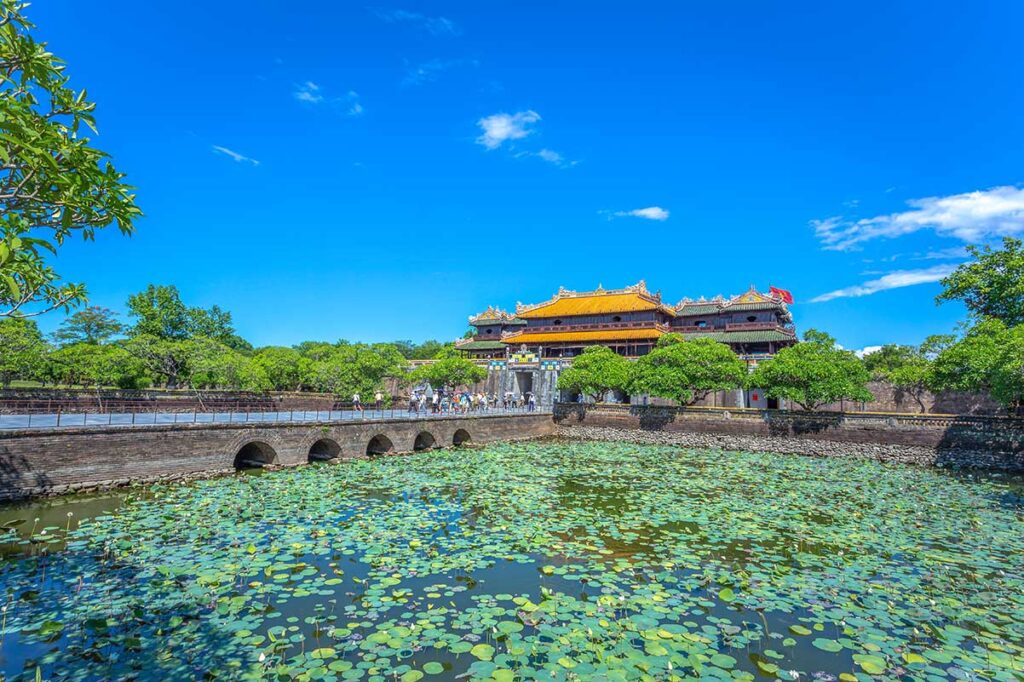
Hue Imperial City is the walled palace complex built in the early 1800s by Emperor Gia Long as the seat of the Nguyen Dynasty. Inspired by the Forbidden City in Beijing, it was once the centre of political and ceremonial life in Vietnam. Parts of the complex were heavily damaged during wars, but many sections have been carefully restored.
You can explore the entire complex with a single entry ticket, making it one of the easiest and most rewarding activities in Hue. As the city’s biggest attraction, it’s a must-do for anyone visiting, whether you’re into history, architecture, or just want to see Hue’s most famous highlight.
Main highlights inside
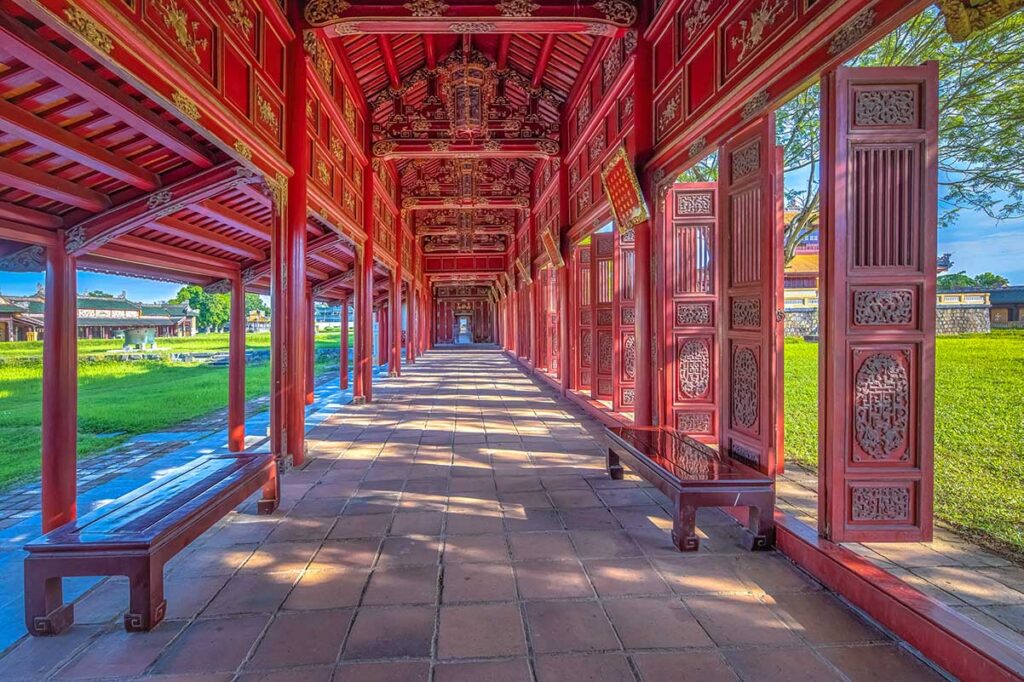
Inside the Imperial City walls, you’ll find several key areas worth exploring. The Forbidden Purple City was once the emperor’s private residence and is still partially in ruins but fascinating to walk through.
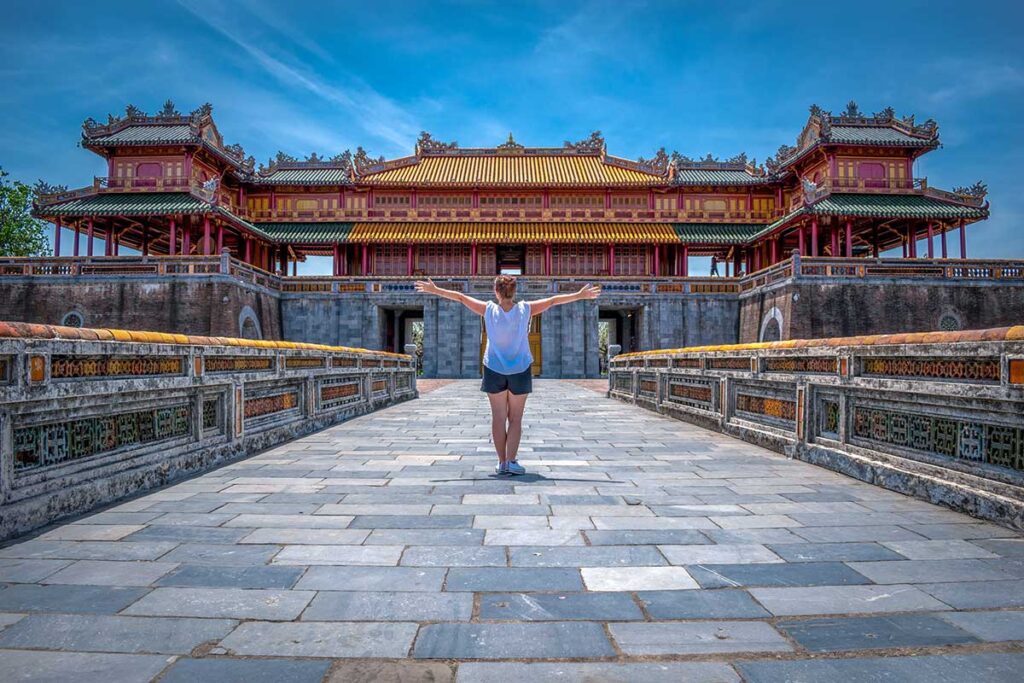
The main gate, Ngo Mon, offers an impressive entry point and photo spot.
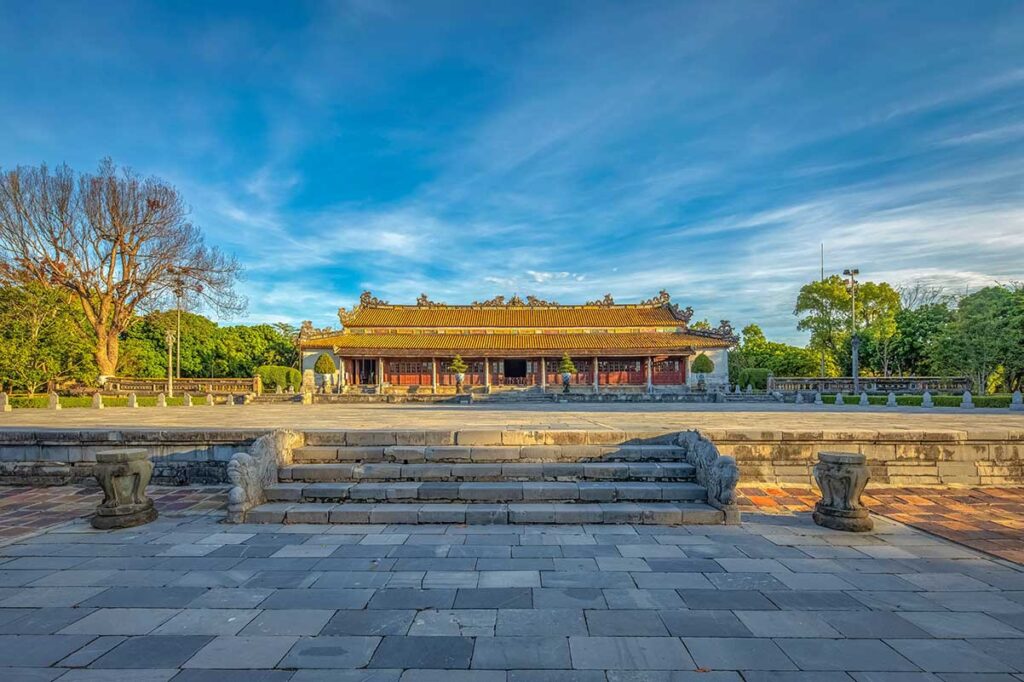
Thai Hoa Palace showcases restored royal architecture and ceremonial halls. You’ll also pass numerous temples, ornate gates, and landscaped gardens that reveal different sides of imperial life.
2. Visit the most impressive royal tombs
The Nguyen emperors built elaborate tombs for themselves, often starting the projects while they were still alive. Each tomb reflects the personality and tastes of the emperor it commemorates, blending traditional Vietnamese design with foreign influences. Hue has many of these tombs, but here are the three most impressive — visiting them is one of the best things to do in Hue if you want to dive deeper into its royal heritage.
Tomb of Khai Dinh – striking European-Asian mix
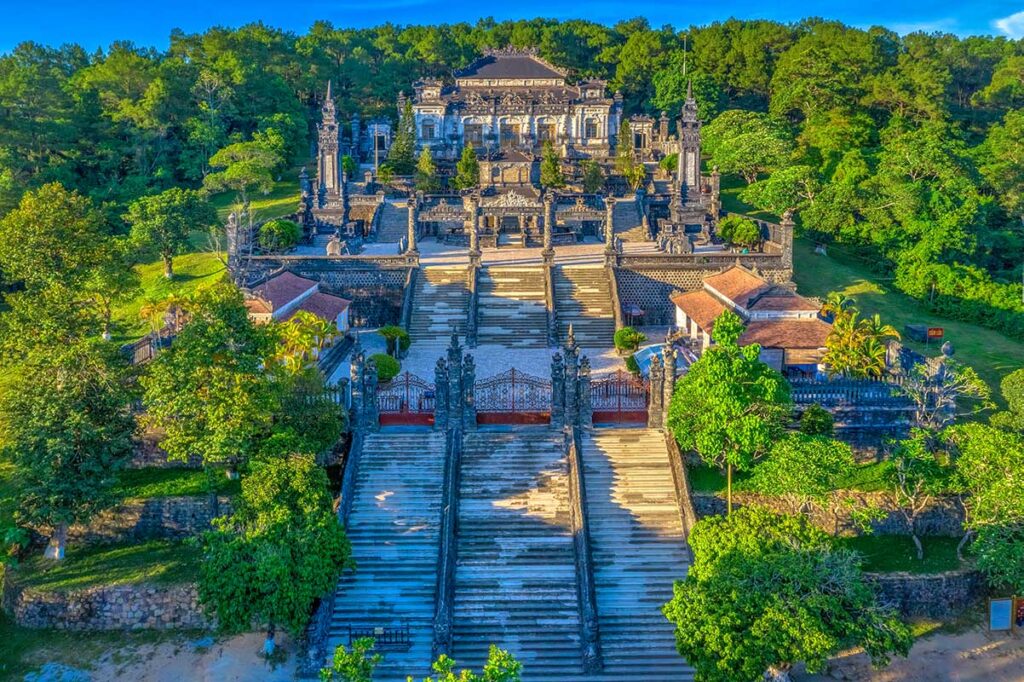
The Tomb of Khai Dinh is unlike any other in Hue, combining Vietnamese, French, and Gothic design elements. Built on a hillside, it features a steep stairway leading to a small but lavishly decorated main hall filled with glass and porcelain mosaics. The blend of Eastern and Western styles makes it a standout among Hue’s royal tombs.
Tomb of Minh Mang – symmetry, gardens, lakes
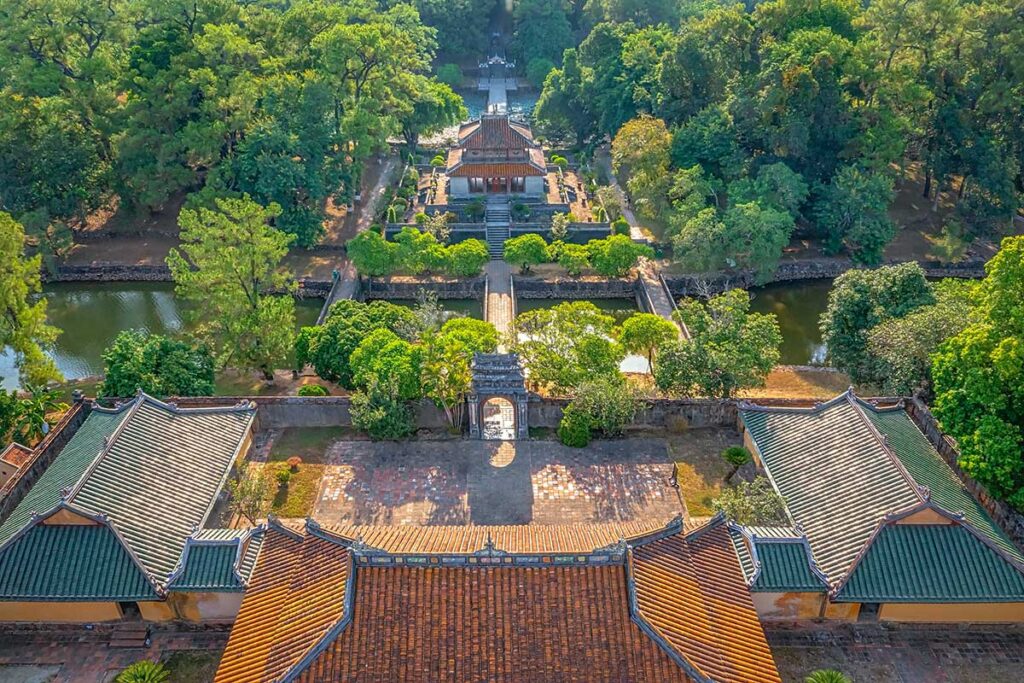
The Tomb of Minh Mang is known for its perfect symmetry and tranquil setting. Surrounded by pine trees and lakes, the complex is laid out along a single axis with gates, courtyards, and temples leading to the emperor’s burial area. It’s a peaceful spot to wander, with beautiful reflections in the water on calm days.
Tomb of Tu Duc – romantic, peaceful setting
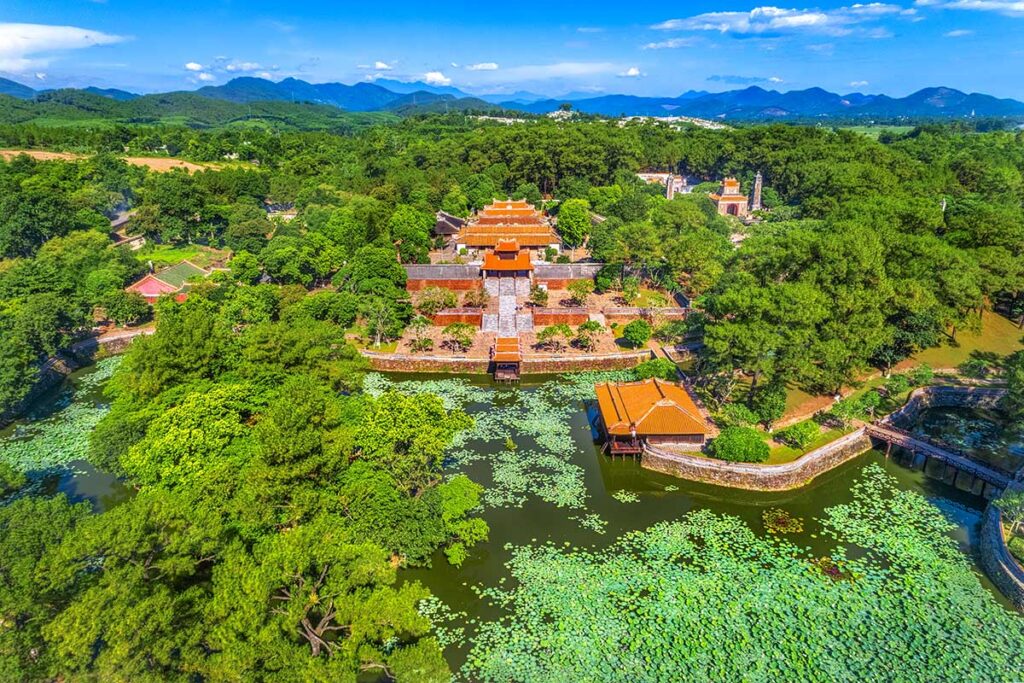
The Tomb of Tu Duc feels more like a retreat than a mausoleum. Built during the emperor’s lifetime, it was used as a holiday residence as well as a place for reflection. The grounds include pavilions, lotus-filled ponds, and shaded walkways, making it one of the most pleasant royal tombs to explore in Hue.
3. Thien Mu Pagoda
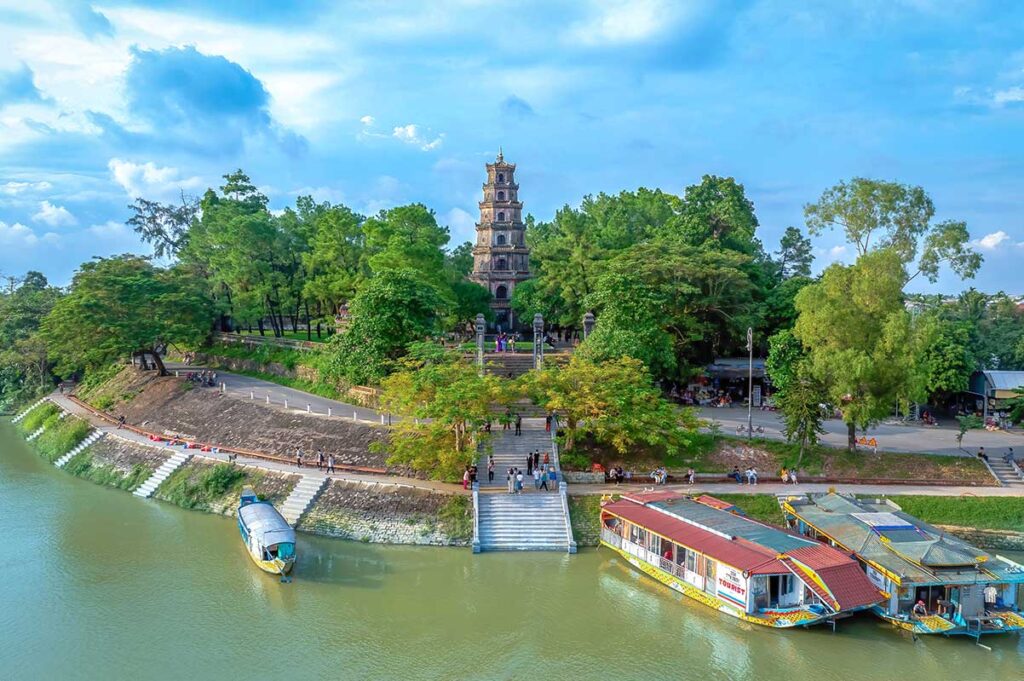
The Thien Mu Pagoda is one of the most recognisable symbols of Hue. Built in the early 1600s, it stands on a hill overlooking the Perfume River and is known for its seven-storey tower, which has become an icon of the city. The pagoda holds an important place in local history and Buddhist culture.
It’s still an active monastery, so you’ll see monks going about their daily routines. The pagoda is a peaceful stop along the river and can easily be combined with a dragon boat trip. For many travellers, pairing a visit here with a sunset cruise is one of the best things to do in Hue.
4. Take a dragon boat ride on the Perfume River
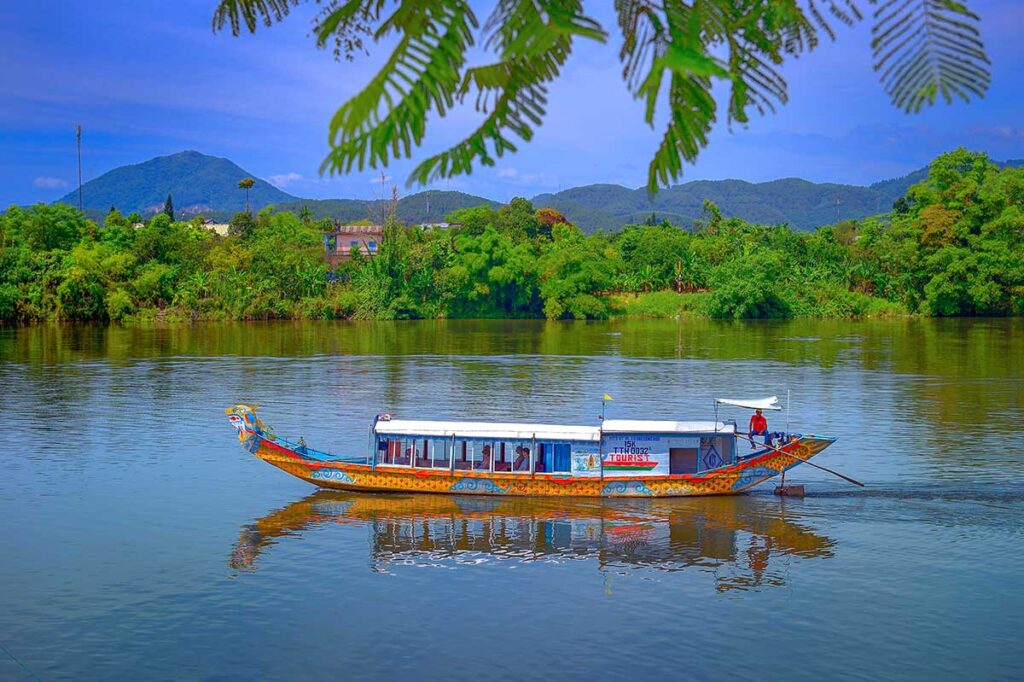
The Perfume River winds through Hue, lined with temples, gardens, and quiet stretches of countryside. Traditional dragon boats — long, brightly painted vessels — offer a relaxed way to take in the scenery from the water.
Boats usually depart from the pier near the Truong Tien Bridge in the city centre. The most popular route goes to Thien Mu Pagoda, but you can also arrange private trips to other riverside sites. A late-afternoon departure with a return at sunset is one of the most atmospheric activities in Hue.
5. Experience local life at Dong Ba Market
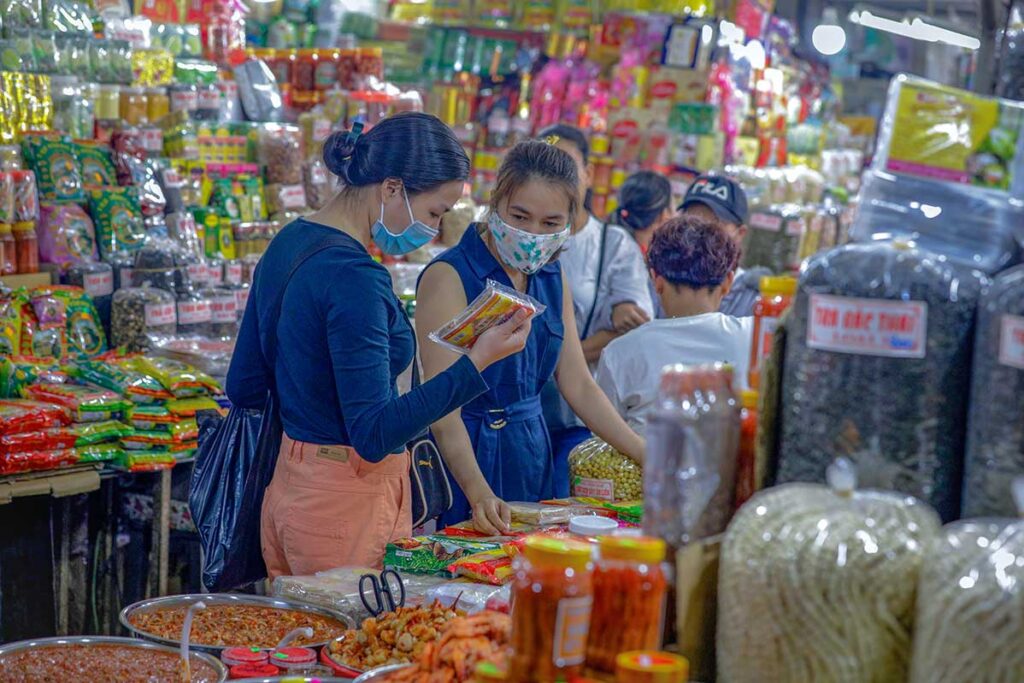
Dong Ba Market is Hue’s largest and most famous market, buzzing with activity from early morning. Stalls are packed with fresh produce, spices, dried goods, household items, and clothing, making it a hub for locals.
It’s not a polished souvenir market, though you can find conical hats, fabrics, and snacks to take home. Some sections have strong food smells and fresh meat displays, so be prepared. For photographers, the mix of colours, textures, and busy scenes make it a rewarding stop.
6. The scenic road to Da Nang
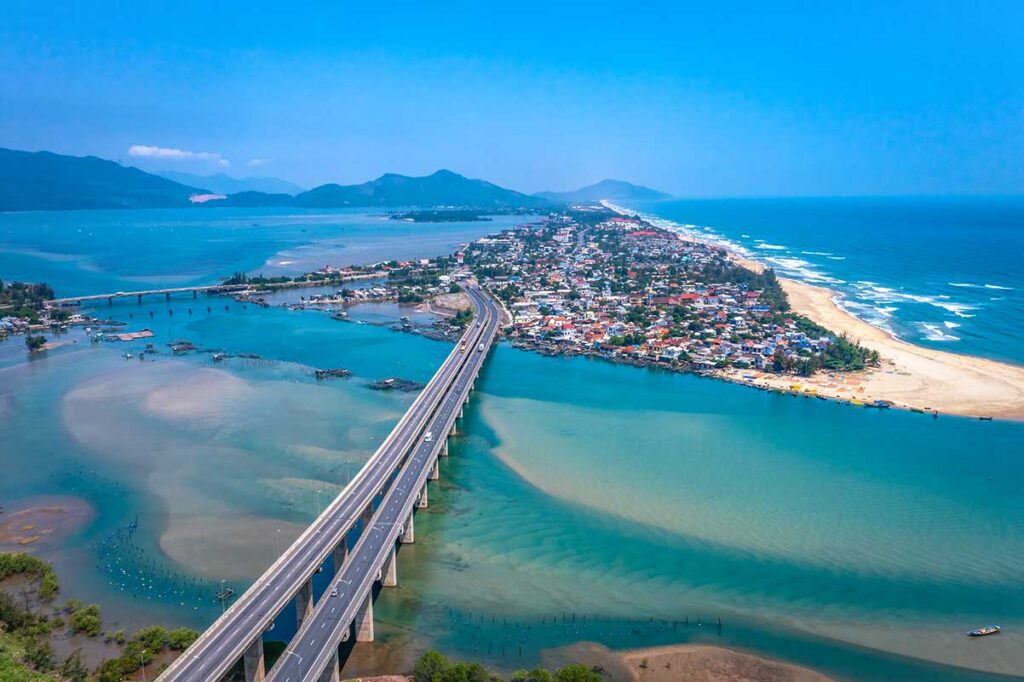
The route between Hue and Da Nang is packed with natural beauty and cultural stops, making it far more than just a transfer. You can do it as a day trip or as part of your journey to Hoi An or Da Nang. The road passes lagoons, mountains, beaches, and waterfalls, and the journey itself can be a highlight of your trip.
You can travel by private car, open-top jeep, or with an Easy Rider on the back of a motorbike. Each option offers plenty of chances to stop for photos and explore.
Lap An Lagoon – oyster farms, peaceful views
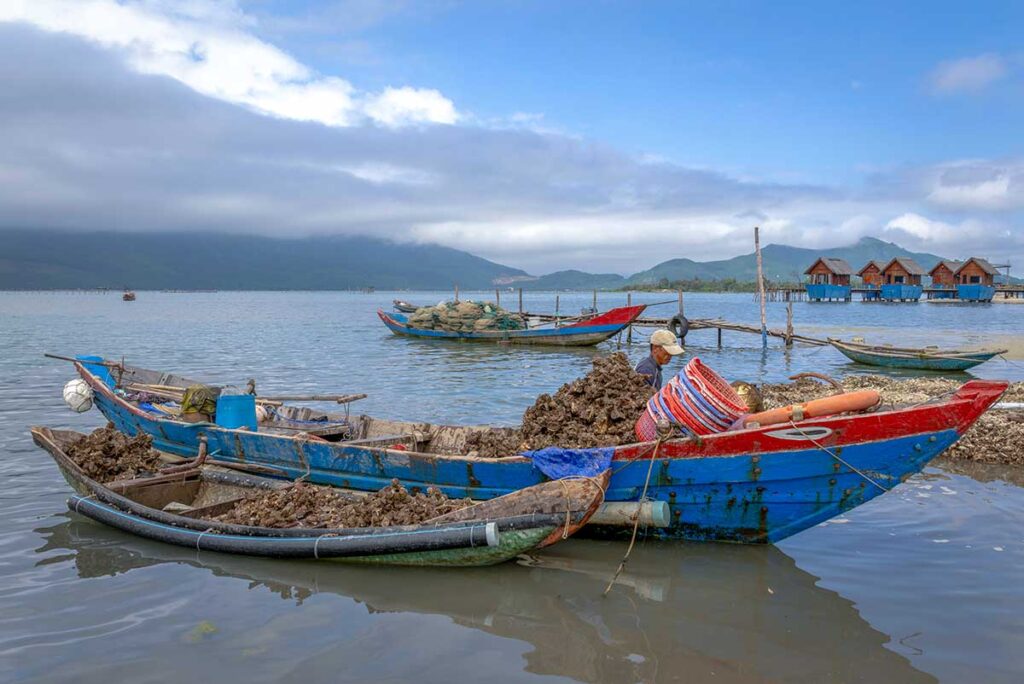
A quiet spot near Lang Co, Lap An Lagoon is surrounded by mountains and dotted with oyster farms. At low tide, you can walk along the sandy flats; at high tide, the reflections are stunning.
Hai Van Pass – winding coastal mountain road
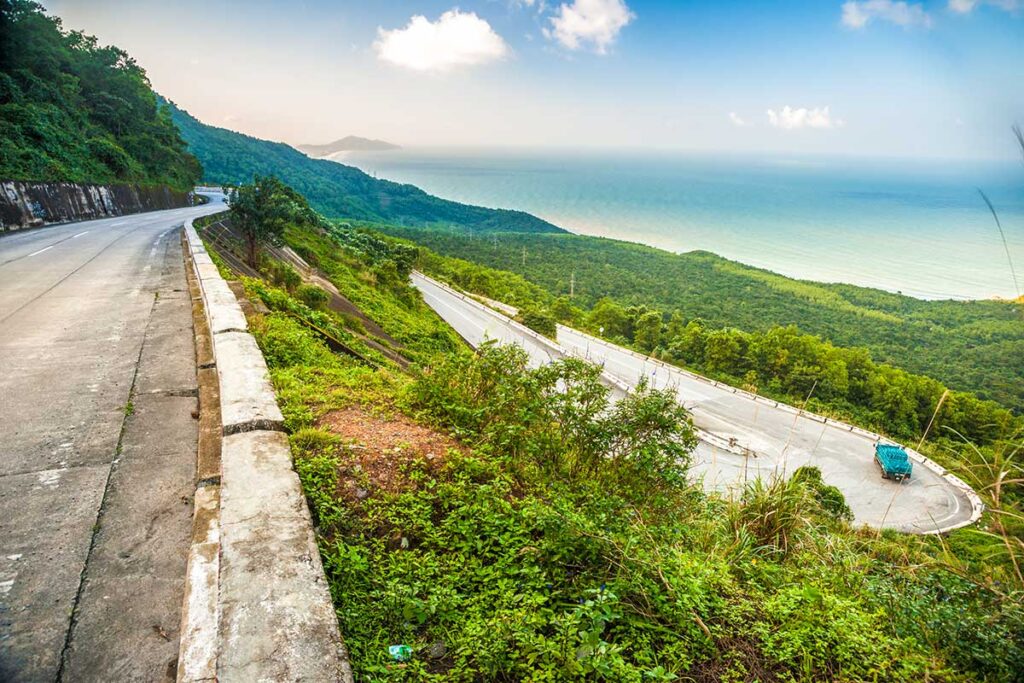
The Hai Van Pass is a winding stretch of road climbing between the mountains and the sea. It’s famous for its panoramic views and was made even more popular by the BBC’s Top Gear. There are several viewpoints along the way.
The Elephant Springs – natural swimming pools
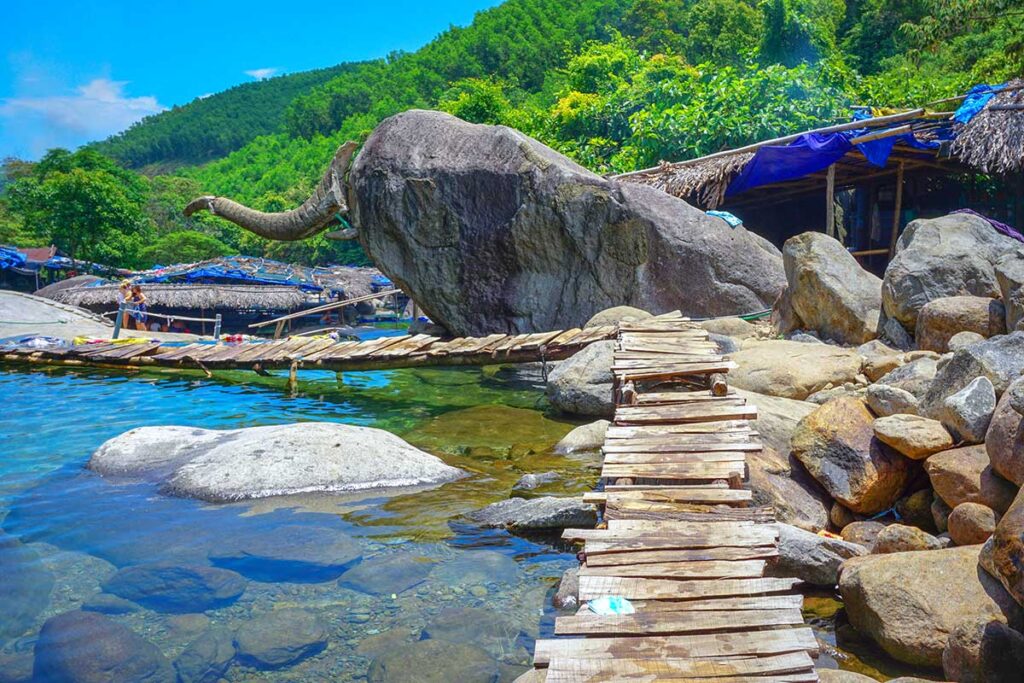
Located in the jungle, the Elephant Springs are a series of natural rock pools perfect for a refreshing swim. Simple huts sell snacks and drinks, and it’s a good place to cool off if you’re travelling in the warmer months.
Lang Co Beach – white sands & seafood
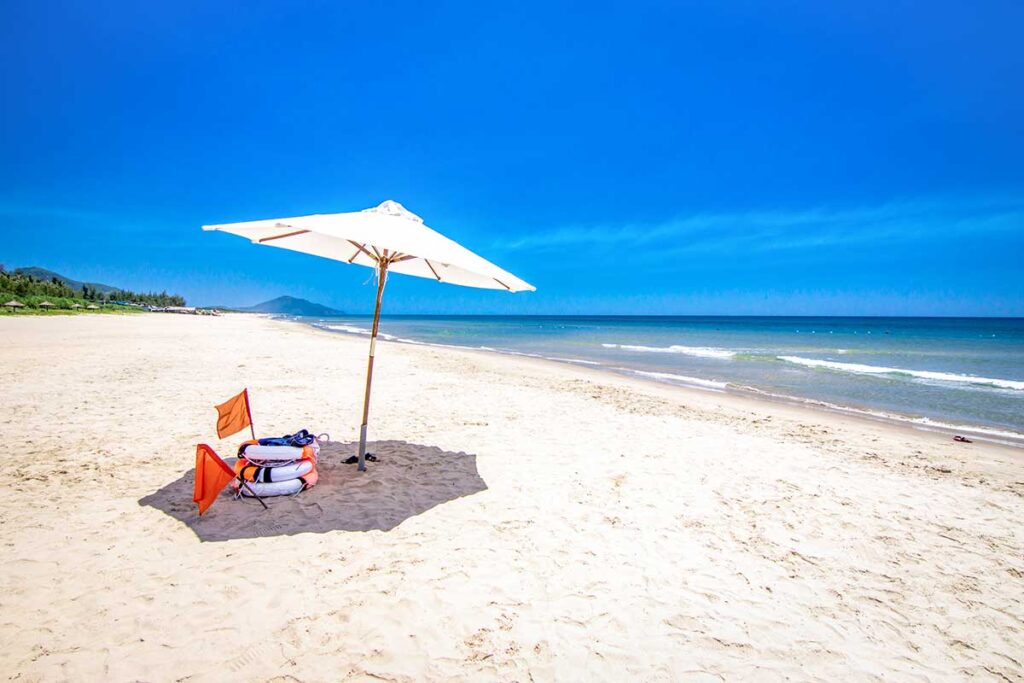
Lang Co Beach offers a long curve of soft white sand backed by a fishing village. It’s a good stop for fresh seafood or a quick swim before continuing the journey to Da Nang or Hue.
7. Bach Ma National Park
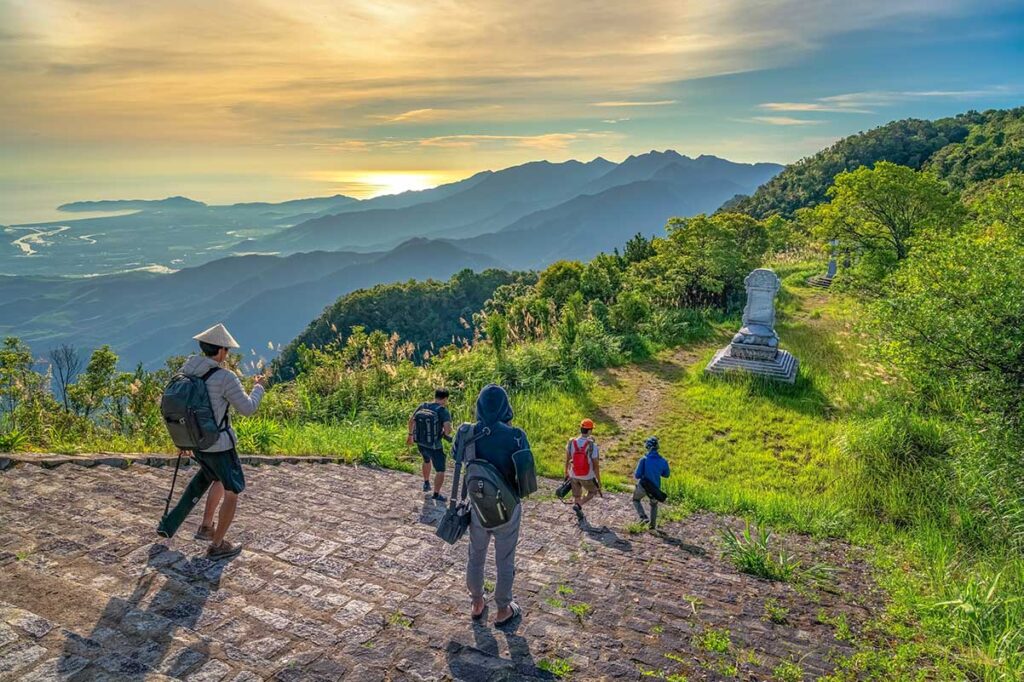
Bach Ma National Park lies about an hour’s drive from Hue and is one of central Vietnam’s most biodiverse areas. Its mountains, forests, and waterfalls provide a refreshing change from the city’s heat and historical sites. The park was once a French hill station, and its cooler climate makes it a pleasant escape.
For visitors, the main draws are the hiking trails, panoramic viewpoints like the Hai Vong Dai, and waterfalls such as Do Quyen. Guided day trips from Hue often include a short trek, wildlife spotting, and time to enjoy the views — making it a top activity in Hue for nature lovers.
8. Day trip to the DMZ
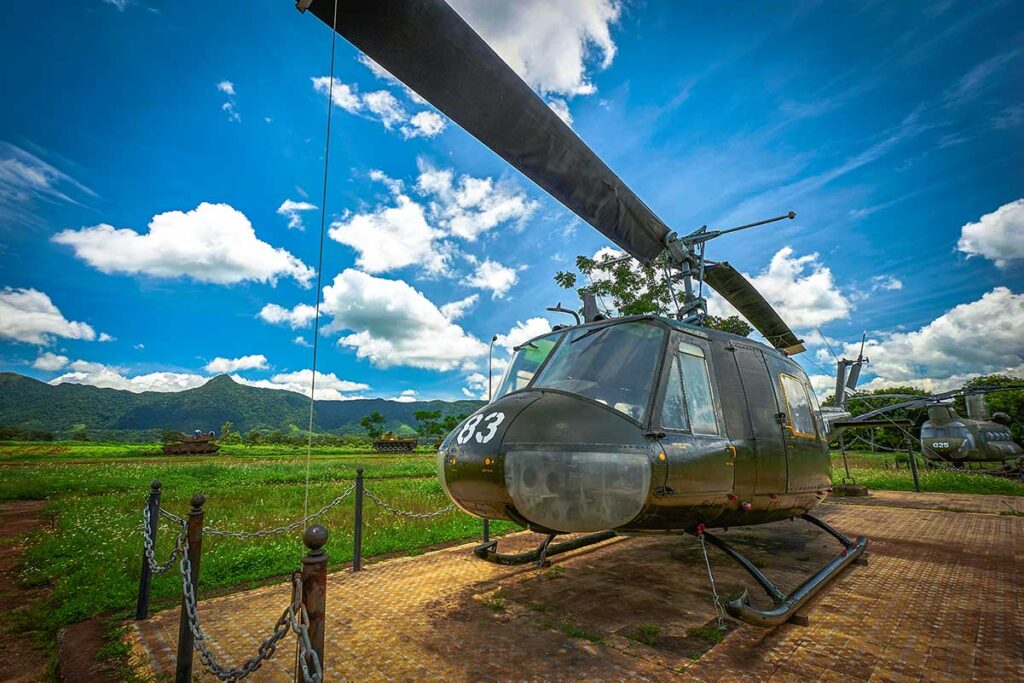
The Demilitarized Zone (DMZ) once marked the dividing line between North and South Vietnam during the war. Located about two hours north of Hue, it’s an area with deep historical significance and remnants from the conflict.
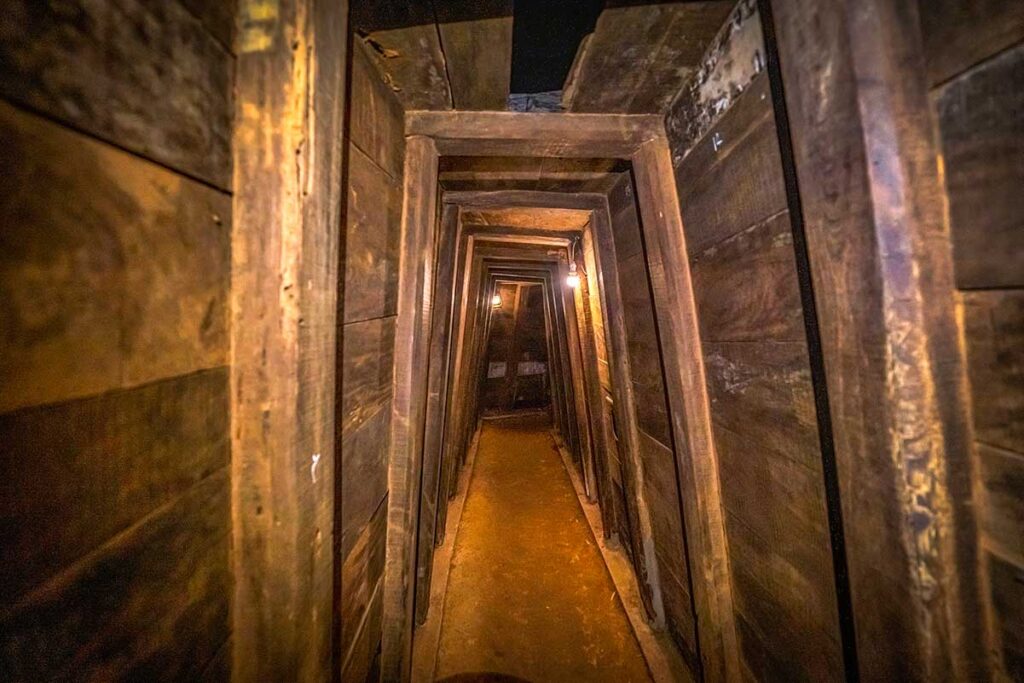
A typical DMZ tour from Hue includes stops at the Vinh Moc Tunnels, where entire villages lived underground, the Khe Sanh Combat Base, Hien Luong Bridge over the Ben Hai River, and various war memorials. It’s one of the most interesting day trips from Hue if you want to understand Vietnam’s modern history.
9. Hue’s abandoned water park (Ho Thuy Tien)
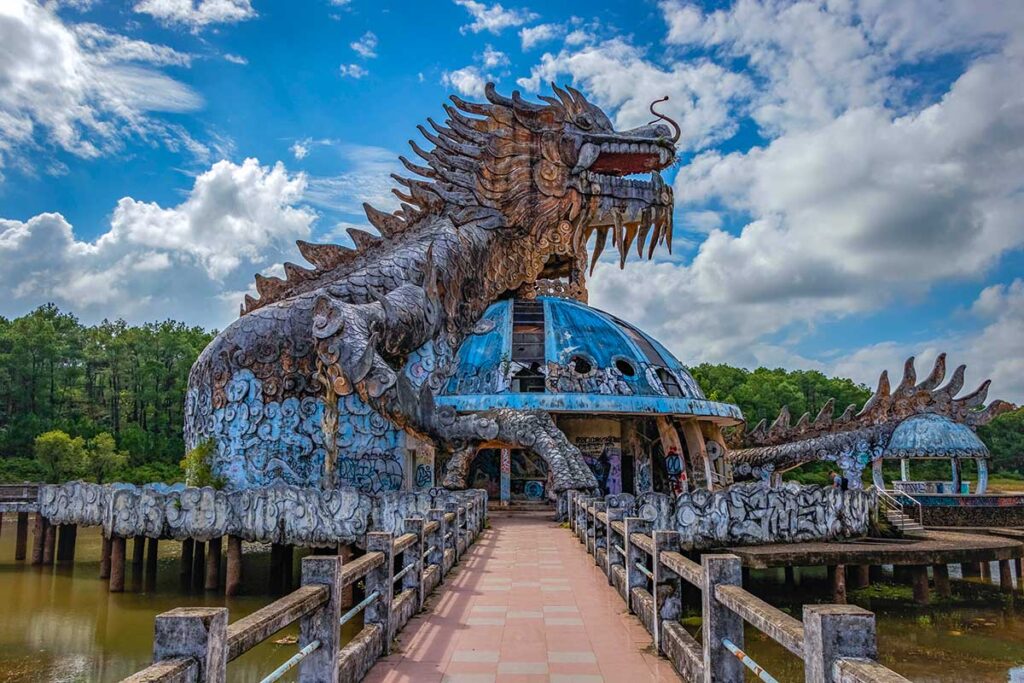
The Ho Thuy Tien Water Park was built in the early 2000s but never fully opened to the public. Intended as a large family attraction with pools, slides, and an aquarium, it fell into disrepair soon after construction.
Today, it’s an eerie but fascinating place to explore. Overgrown pathways, empty pools, and a huge dragon structure on the lake have turned it into an unofficial tourist spot. While it’s technically closed, many travellers still visit — often paying a small fee to on-site guards for access.
10. Sunset at Vong Canh Hill viewpoint
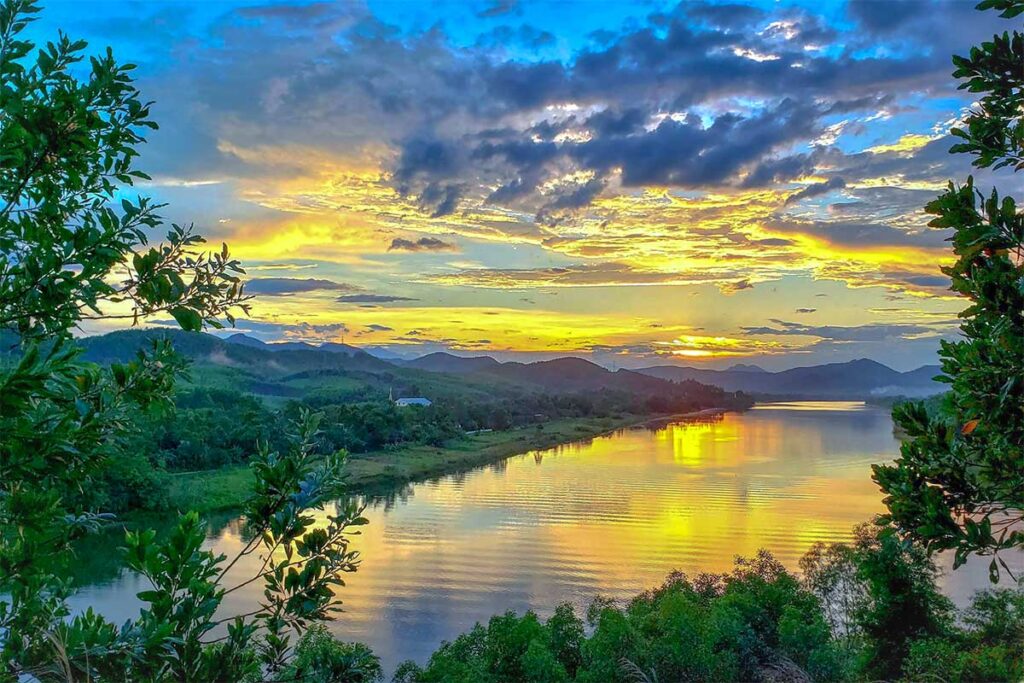
Vong Canh Hill offers one of the best sunset views in Hue, overlooking a bend in the Perfume River framed by mountains and greenery. It’s a peaceful spot with benches and shaded areas to sit and enjoy the view.
It’s also close to several other attractions, making it easy to combine with a visit to the Thuy Xuan incense-making village or nearby royal tombs such as Tu Duc. For photographers, this is one of the most rewarding places to end a day of sightseeing in Hue.
11. Traditional craft villages
Visiting Hue’s traditional craft villages is a great way to experience local culture beyond the main historical sites. These small communities have been practising their trades for generations, and seeing them at work can be just as memorable as visiting the city’s monuments. If you’re looking for more authentic activities in Hue, these villages are worth adding to your itinerary.
Incense-making village (Thuy Xuan)
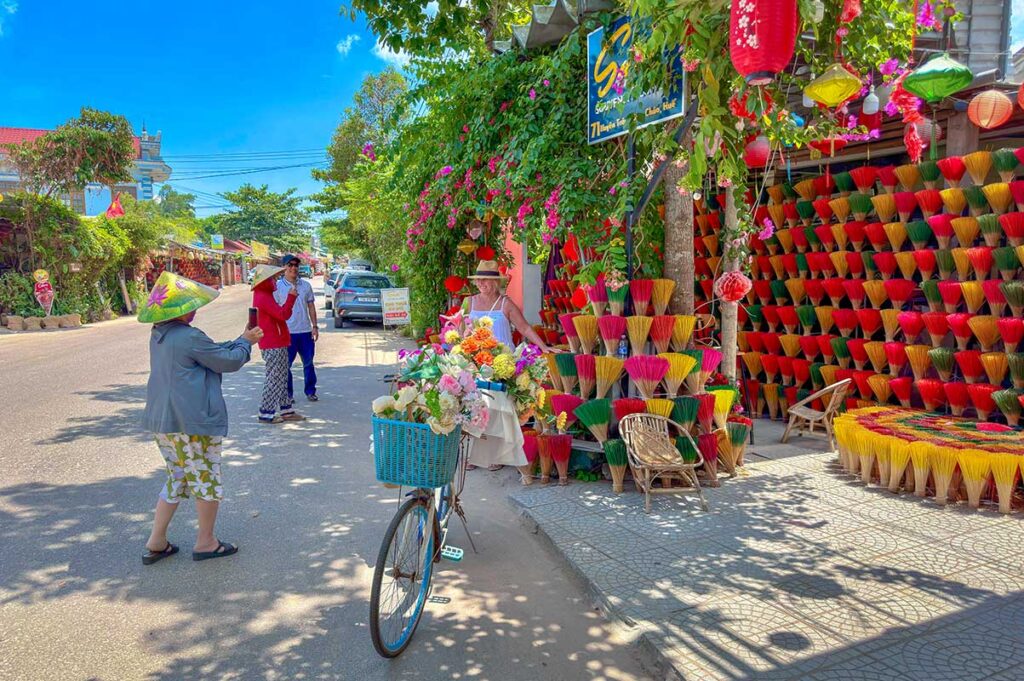
The Thuy Xuan incense-making village is instantly recognisable for its brightly coloured incense sticks arranged in flower-like displays along the roadside. While it’s partly set up for tourists, you can still see locals hand-rolling incense and learn about the process. It’s also a fantastic photo stop and easy to combine with nearby tombs or Vong Canh Hill.
Conical hat village
In Hue’s conical hat villages, artisans make Vietnam’s iconic nón lá. Hue’s hats are known for having poems or patterns woven into the palm leaves, visible when held up to the light. Watching the delicate hand-stitching process gives you a deeper appreciation for this symbol of Vietnamese culture.
12. Discover Hue’s nightlife
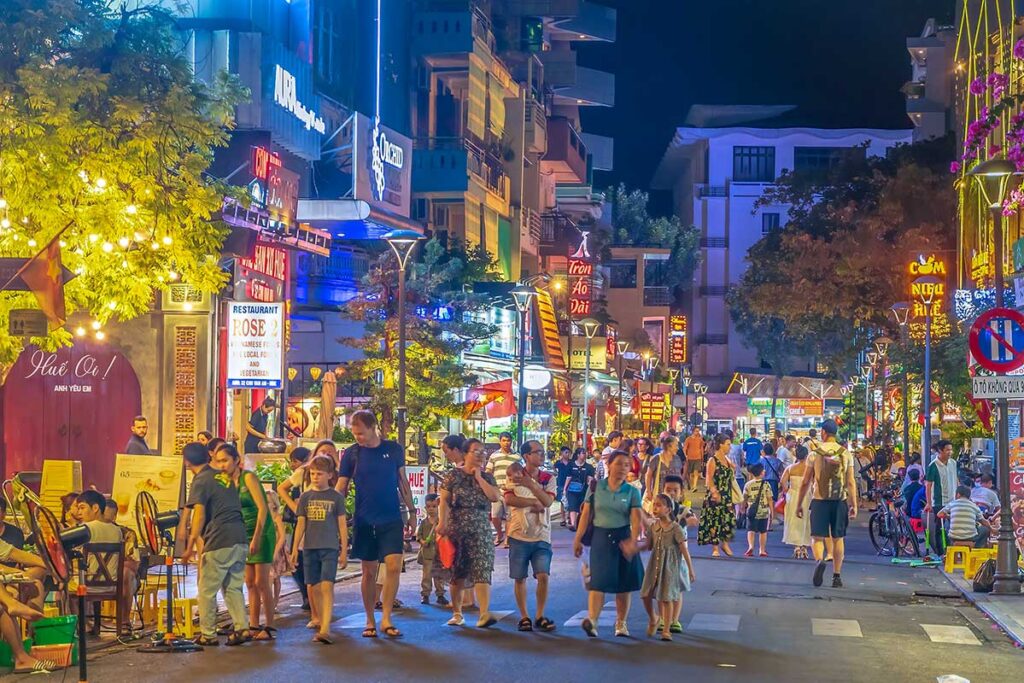
While Hue is best known for its imperial history, its nightlife scene offers a change of pace. The Walking Street area comes alive on weekend evenings with live music, street performers, and open-air cafés. Along the Perfume River promenade, you can stroll under lit bridges or take a short evening boat ride.
There are also a few relaxed bars and beer spots popular with both locals and travellers. It’s not as busy as bigger cities, but enjoying an evening out here is still one of the more laid-back things to do in Hue.
13. An Dinh Palace
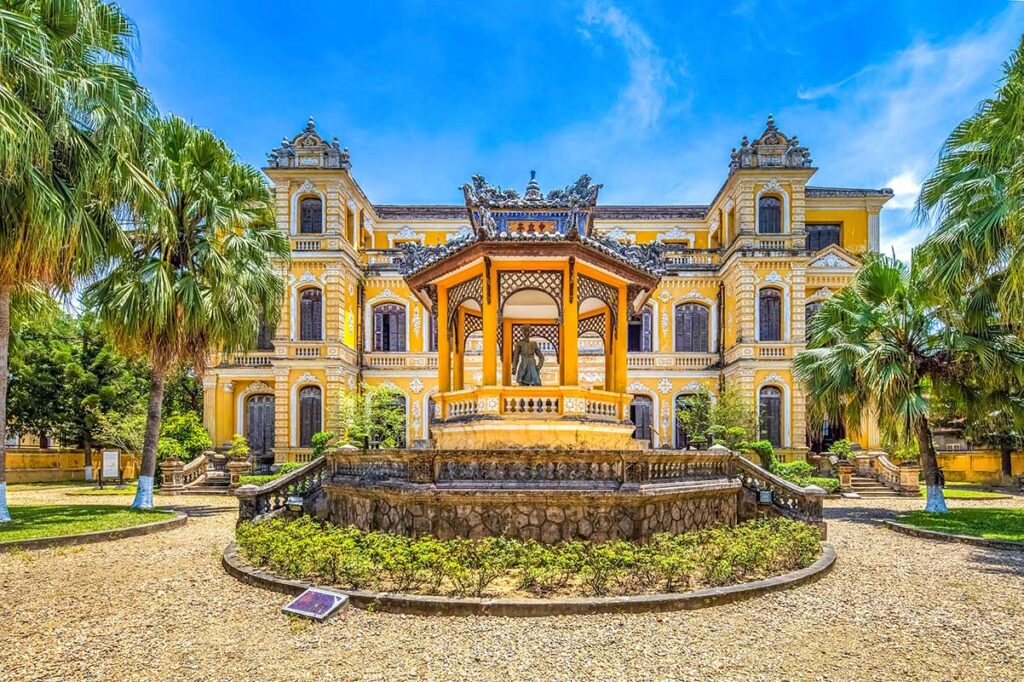
The An Dinh Palace was built in the early 20th century as a residence for Emperor Khai Dinh before he moved to the Imperial City. Its design blends European architecture with Vietnamese decorative details, and the interior includes a richly painted audience hall.
The palace is located in the city, making it an easy stop if you’re exploring by bicycle or taxi. It’s open daily with a small entry fee, and an hour is enough to see the main rooms and gardens.
14. Hue food and royal cuisine
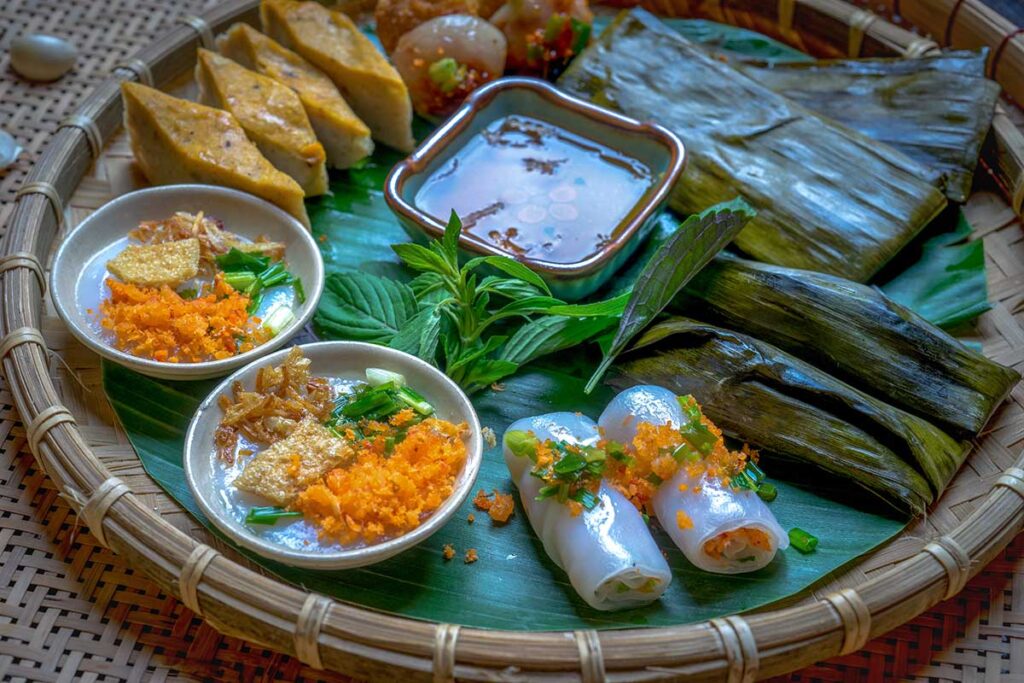
Hue is considered Vietnam’s culinary capital, famous for its imperial dishes as well as everyday street food. Royal cuisine was once served only to the Nguyen emperors and is still recreated at certain restaurants, while the city’s street food scene is vibrant and affordable. Experiencing the variety of Hue’s food is one of the best things to do in Hue, and here are two great ways to do it:
Street food tour
A street food tour takes you to local markets, small eateries, and street stalls you might not find on your own. Some tours are done by cyclo, letting you enjoy the city at night while tasting local favourites like bún bò Huế, bánh bèo, and nem lụi.
Local cooking class
Joining a cooking class in Hue is a hands-on way to learn about the city’s flavours. You’ll usually start with a market visit to buy ingredients, then prepare a few traditional dishes under the guidance of a local chef. It’s a fun activity in Hue that you can take home with you — literally, in the form of recipes.
15. Discover Hue’s countryside by bicycle
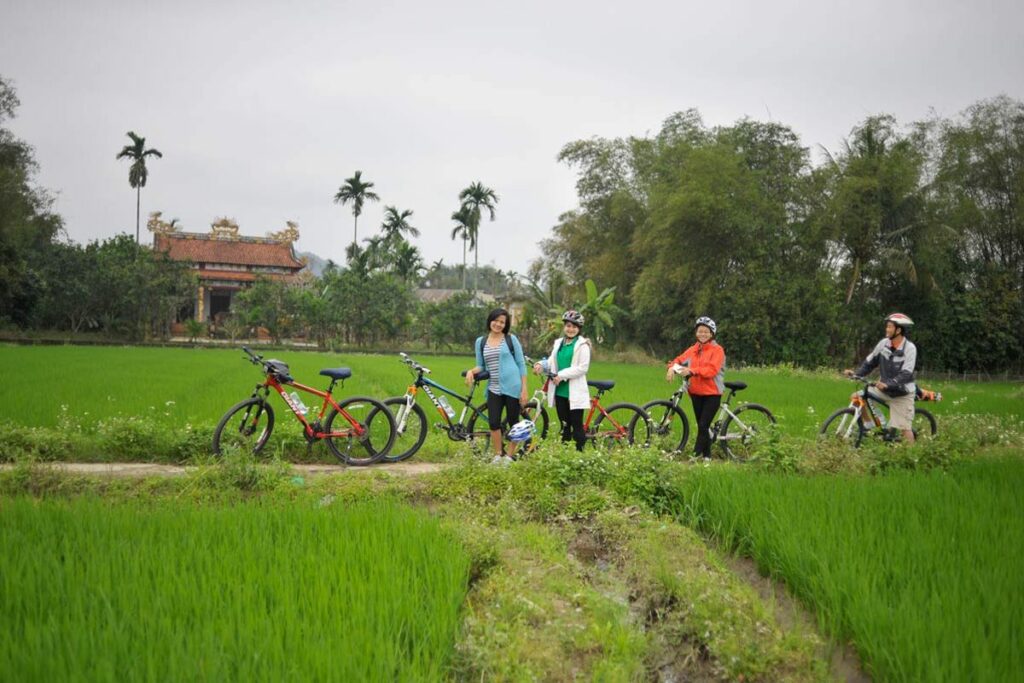
Cycling is one of the most enjoyable ways to experience Hue’s quieter surroundings. Just a short ride from the city centre takes you past rice paddies, small villages, and friendly locals going about their day. The flat terrain and relatively light traffic make this one of the easiest cities in Vietnam for cycling.
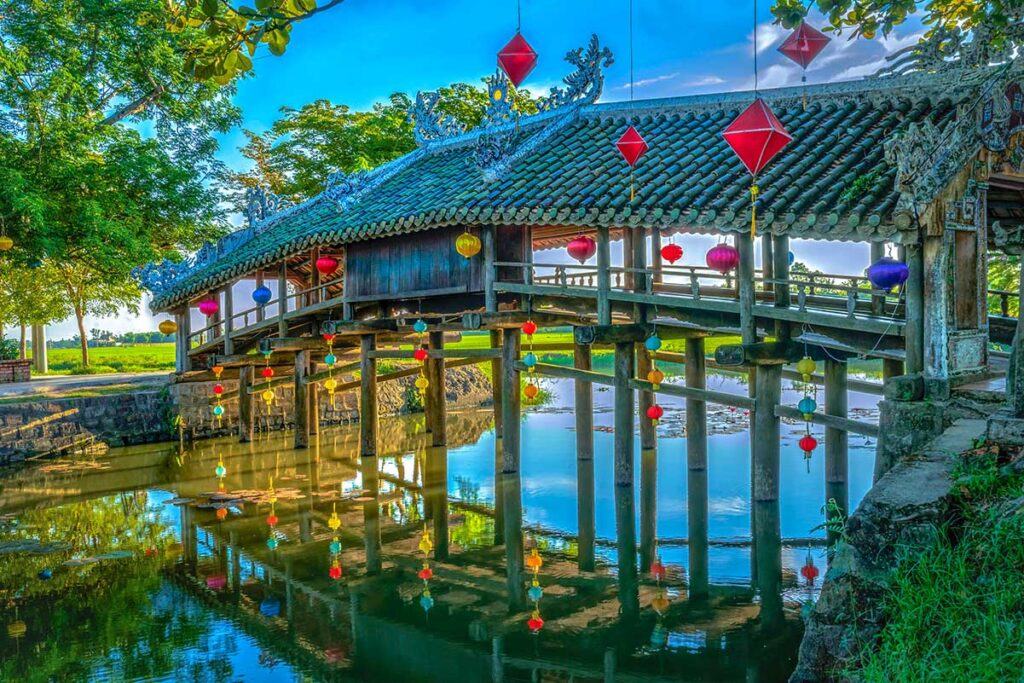
A popular countryside route leads to the Thanh Toan Bridge, a rare wooden and tile-roofed bridge dating back to the 18th century. The area also has a small agricultural museum and local market. You can explore independently with a rental bike, or join a guided countryside tour to visit hidden pagodas, rural craft workshops, and peaceful riverbanks.
16. Hidden spots & less touristy sites
Hue has many famous highlights, but some smaller or less-visited spots can be just as rewarding. If you’re wondering what to do in Hue beyond the obvious sights, these places offer a quieter, more local perspective.
Hon Chen Temple – riverside religious site
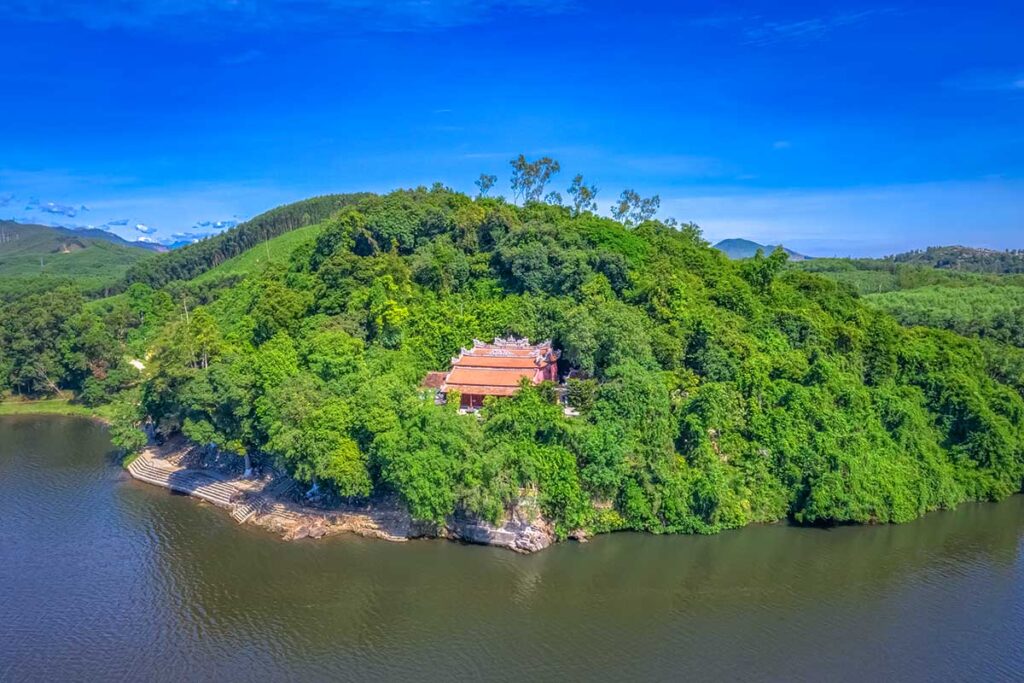
The Hon Chen Temple sits along the Perfume River and is dedicated to a local goddess. It’s an active place of worship, especially lively during annual festivals when boats decorated with offerings approach the temple.
Ho Quyen Tiger Arena – elephant & tiger fights history
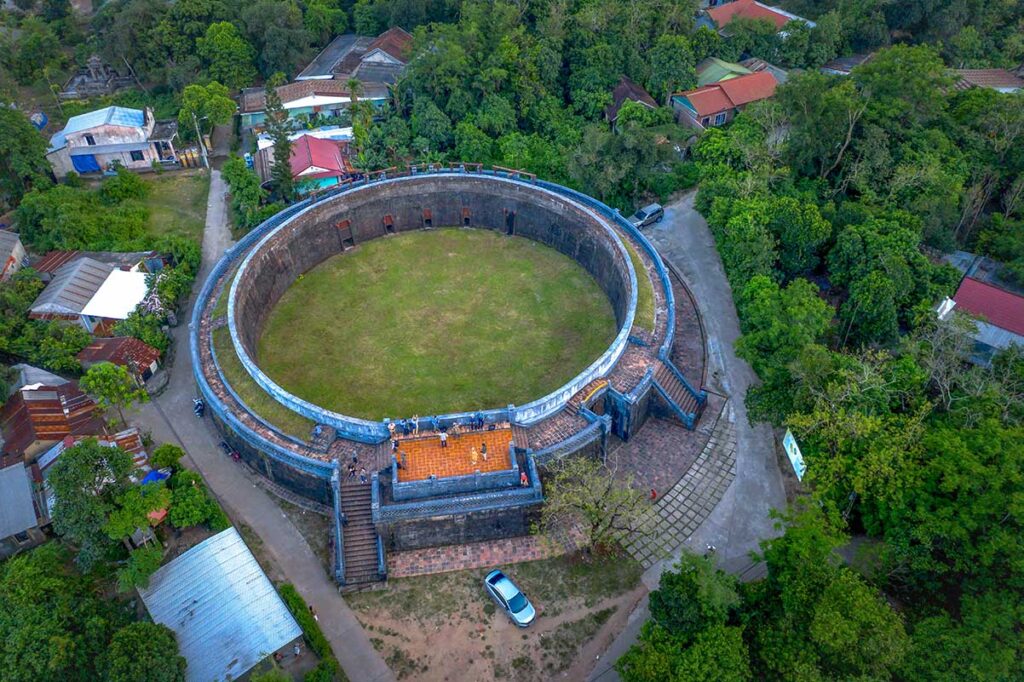
The Ho Quyen Tiger Arena is a circular stone structure where, in the past, fights between elephants and tigers were staged for the royal court. It’s partially ruined but still an intriguing piece of Hue’s history.
Gia Long Tomb – remote, less visited royal tomb
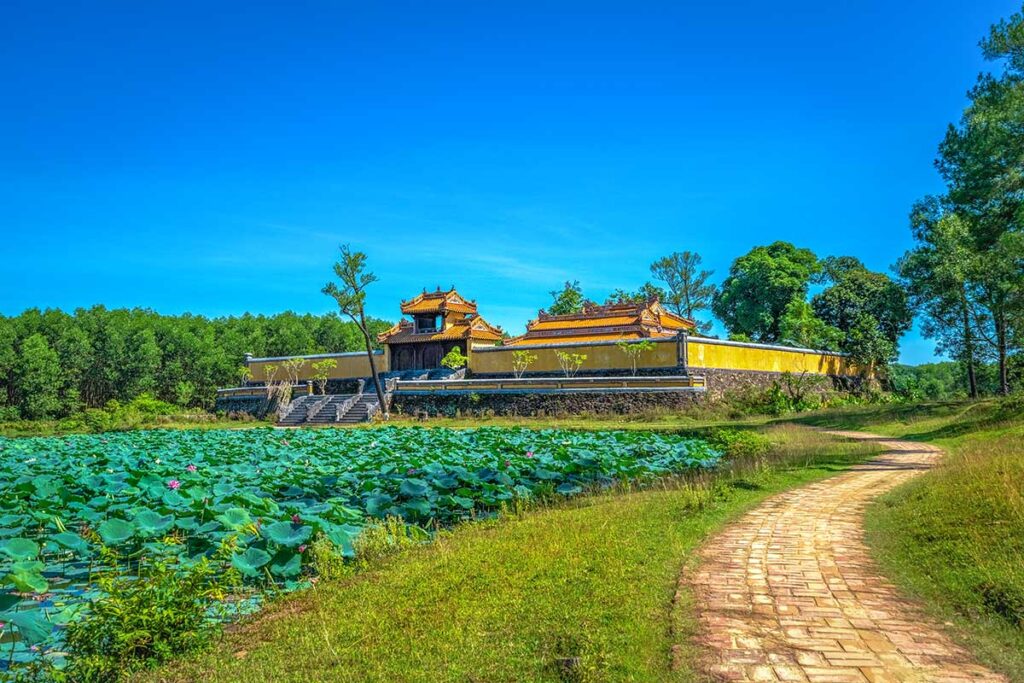
The Gia Long Tomb is the burial site of the first Nguyen emperor and is set in a quiet, rural area. Fewer tourists come here, so it’s a peaceful alternative to the more famous tombs.
Phu Cam Cathedral – modern architecture
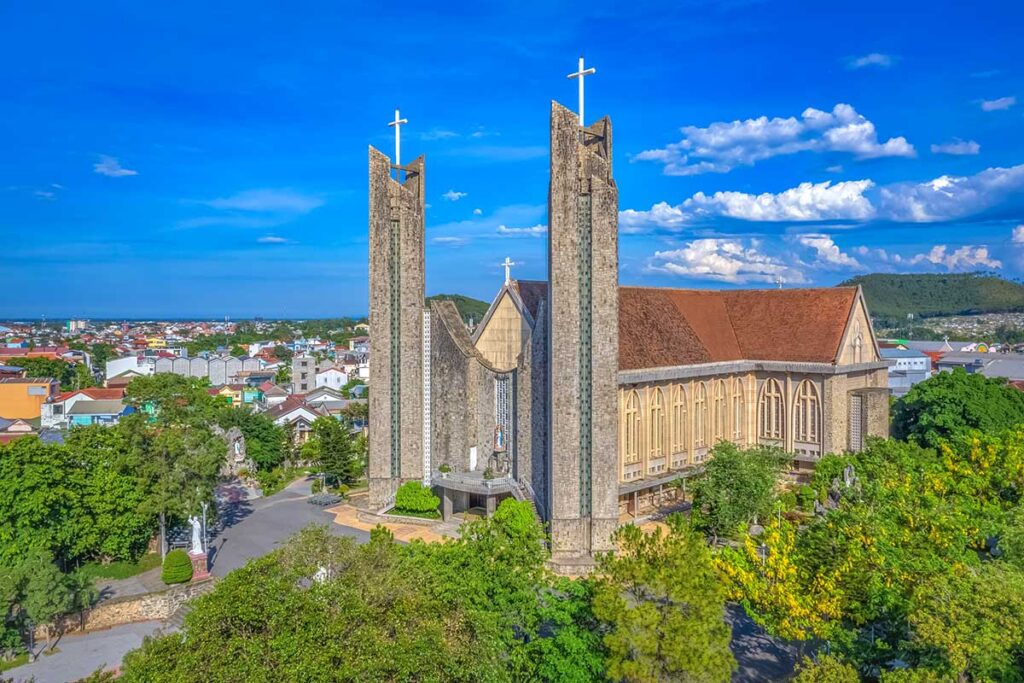
The Phu Cam Cathedral is an example of modernist architecture in Hue. Its concrete structure and unique design contrast sharply with the city’s traditional temples and palaces, making it a quick but interesting stop.
Best time to visit Hue
Hue can be visited year-round, and most of the best things to do in Hue involve exploring historical buildings rather than purely outdoor scenery. That said, the weather can still affect your comfort, even for city sightseeing.
The best time to visit is during the dry season from March to August, when you can expect plenty of sunshine and minimal rain. Temperatures range from warm to very hot, with the peak summer months (June–August) often reaching 35°C (95°F) or higher.
The rainy season runs from September to February, with the heaviest rainfall in October and November. Flooding can occur during these two months, but usually only for a few days at a time. If you travel during this period, bring a light raincoat and plan some indoor activities for wet days.
For more details on weather patterns and monthly travel tips, see our dedicated guide about the best time to visit Hue (it includes a month-to-month overview of what to expect).
Where to stay in Hue
The best place to stay in Hue is in the city centre on the south side of the Perfume River, directly across the bridge from the Imperial City. This is where most hotels, guesthouses, and homestays are located, as well as the highest concentration of restaurants, cafés, and bars.
If you choose accommodation in this central area, you can easily explore most of the best things to do in Hue without long taxi rides, while also being in the heart of Hue’s dining and nightlife area. Many hotels in this part of the city also offer bicycle rentals, making it easy to explore the riverfront, markets, and other attractions at your own pace.
Food & drinking in Hue
Royal food & local dishes
Hue is famous for its imperial cuisine, once prepared for the Nguyen emperors with an emphasis on presentation and delicate flavours. Some restaurants still serve royal banquets, while others focus on regional specialities like bún bò Huế (spicy beef noodle soup), bánh bèo (steamed rice cakes), and nem lụi (lemongrass skewers). Sampling both royal dishes and street food is one of the tastiest activities in Hue.
Range of restaurants
In the city centre, you’ll find everything from family-run eateries to Western-style restaurants and vegetarian cafés. Most of these are clustered around the main tourist streets, making it easy to try a different spot each night. Street food is also abundant — you can join a guided tour or simply explore the market stalls for an authentic taste of local life.
Nightlife in Hue
Hue is not a party city, but it does have a relaxed nightlife scene. Walking Street comes alive on weekend evenings with live music, street performances, and outdoor seating. The same area is still the hub for bars and restaurants during the week, ranging from backpacker pubs to stylish cocktail lounges and local beer spots.
For a quieter evening, you can stroll along the Perfume River promenade and enjoy the illuminated bridges. Night markets also pop up on certain evenings, offering snacks and souvenirs. For more details, see our full guide to nightlife in Hue, which covers the best bars, night markets, and evening activities.
How to get there
Flights to Hue
Hue has a small international airport, with daily flights from Ho Chi Minh City and Hanoi. Hue’s Phu Bai International Airport is currently served by Vietnam Airlines and Vietjet.
Buses to Hue
Hue is connected by bus to other cities in Central Vietnam. Buses run daily from Hoi An and make the journey to Hue in about three and a half hours. There are also daily buses from other cities, such as Ninh Binh, Phong Nha, Dong Hoi, Da Nang and even from Ho Chi Minh City and Hanoi.
Trains to Hue
Hue train station is one of the many stops on the Hanoi to Ho Chi Minh City train route that goes through the largest part of Vietnam. The train journey from Hue to Da Nang is a very beautiful route that is even worth doing as an excursion.
Private transportation
A great alternative is getting private transportation. The route between Hue and Da Nang/Hoi An goes over the Hai Van pass, a stunning coastal road. On the way there are a few sights that you can visit too.
If you go north to Phong Nha, you can visit the sights that are located in the DMZ.
You can either go by Easy Rider or private car for both routes.
How to get around
Taxis and Grab
Taxis are easy to find in Hue, but some drivers may take a longer route if you don’t know the area. Reliable companies include the green Mai Linh and yellow Taxi Vang, both of which use meters. These days, Grab (ride-hailing app) is more commonly used by travellers for both cars and motorbikes, often cheaper and more convenient than a regular taxi. For attractions outside the city centre, such as some royal tombs, it’s worth asking your driver to wait for you and agree on a return price in advance.
Cyclos and motor taxis
Cyclos (three-wheeled bicycle taxis) and motor taxis are still popular for short rides and sightseeing. Prices are negotiable, so expect to agree on a fare before you start your trip. A cyclo ride can be a fun way to see the city at a slower pace.
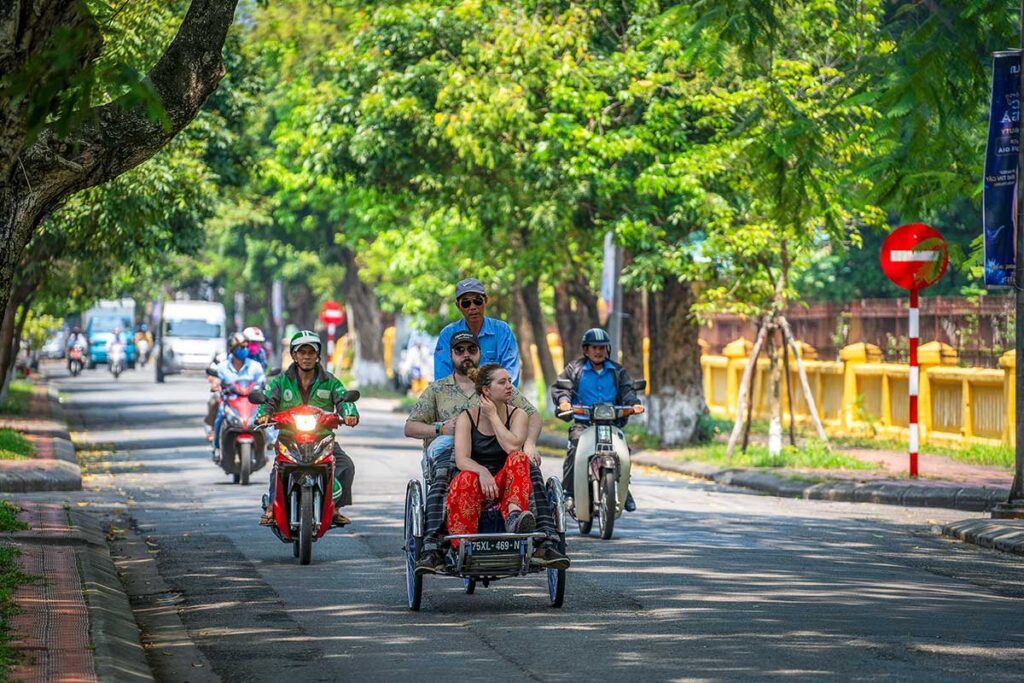
Cycling
Hue is one of the better cities in Vietnam for cycling, especially if you want to explore the riverside, markets, and nearby villages. Many hotels and guesthouses offer bikes for rent, and there are also bicycle shops in the city centre.
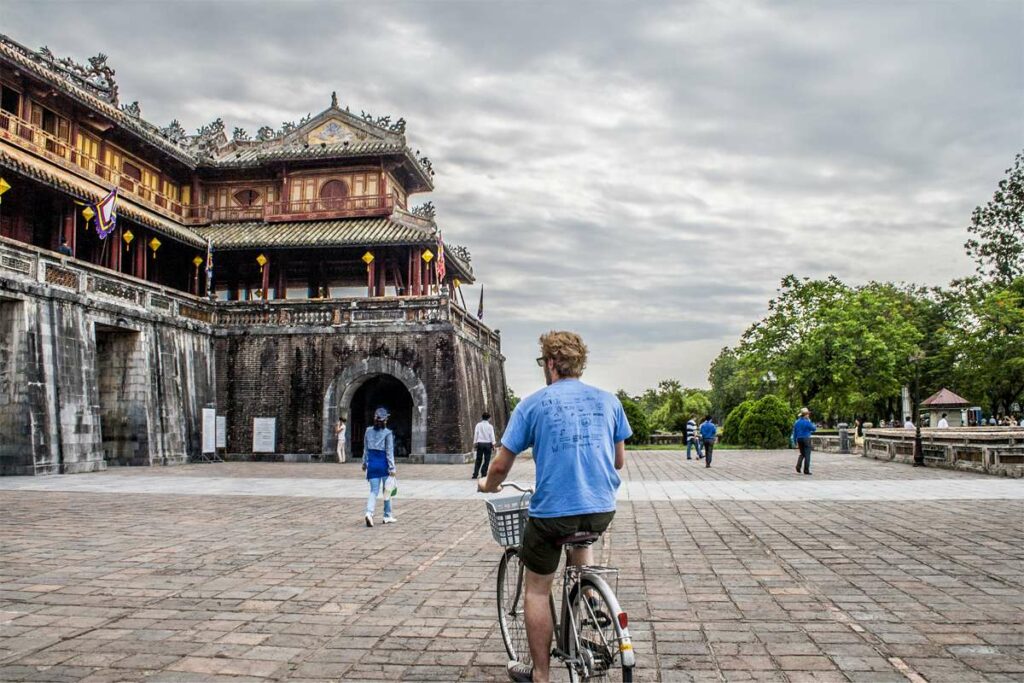
Walking
Hue is one of the most walkable cities in Vietnam, with wider sidewalks and less crowded streets than in bigger cities. While not all attractions are within walking distance, you can easily stroll from the main city centre to the Imperial City by crossing one of the bridges over the Perfume River. Within the city centre, restaurants, cafés, and bars are all within easy walking reach.
Tours
If your time in Hue is short, joining a small-group or private tour can be the most efficient way to see the main highlights in one go. Tours include hotel pick-up and transport between attractions, so you don’t have to arrange each transfer yourself. Many tours combine the Imperial City with royal tombs, pagodas, and markets, making the most of your day.
Itinerary 2 days in Hue
This 2-day itinerary covers the key sights and experiences to make the most of your time in Hue. If you want a detailed breakdown with timings and travel tips, see our complete 2-day Hue itinerary.
Day 1
- Dragon boat trip on the Perfume River
- Visit Thien Mu Pagoda
- Explore Hue Imperial City
- Browse Dong Ba Market
- See Minh Mang Tomb
- Visit Khai Dinh Tomb
- Stop at the Thuy Xuan incense-making village
- Evening walk along the Perfume River promenade
Day 2
Choose one of the following options:
- Option 1: Explore hidden spots such as Gia Long Tomb, Ho Quyen Tiger Arena, and the abandoned water park
- Option 2: Day trip to the DMZ (Vinh Moc Tunnels, Khe Sanh Combat Base, Hien Luong Bridge)
- Option 3: Trekking in Bach Ma National Park
Tips for traveling to Hue
How long to spend in Hue
Most travellers stay in Hue for just one day to see the main highlights. This is possible if you plan well, but it can feel rushed. If you want to explore more historical sites at a relaxed pace or add day trips to the DMZ or Bach Ma National Park, consider staying 2–3 days.
What to wear at Hue’s historical sights
In our experience, dress codes at Hue’s tombs, temples, and the Imperial City are not strictly enforced — you won’t be turned away for wearing a tank top. That said, these are heritage sites and places of cultural importance, so it’s respectful to dress modestly. Light, breathable clothing that covers your shoulders and knees is a good choice, especially in hot weather.
ATMs and money
Hue is a large city with plenty of ATMs, especially in the central tourist area. Most accept international cards, though some may have lower withdrawal limits. Credit cards are accepted at mid-range and higher-end restaurants and hotels, but cash is still the norm at markets, street food stalls, and small shops.
Hue with kids
Hue is one of Vietnam’s more relaxed cities, making it a good stop for families. Kids can enjoy cycling along quiet roads, exploring the open spaces of the Imperial City, or taking a boat trip on the Perfume River. On hotter days, you can cool off with a visit to the beach at Lang Co or at a hotel pool.
Where to go next?
Hue is well-positioned for exploring central Vietnam. Heading south, you can reach Da Nang for beaches or continue to Hoi An for its historic Old Town. To the north, you can visit Phong Nha and its spectacular caves, or travel further to Ninh Binh for limestone mountains and rice fields.
